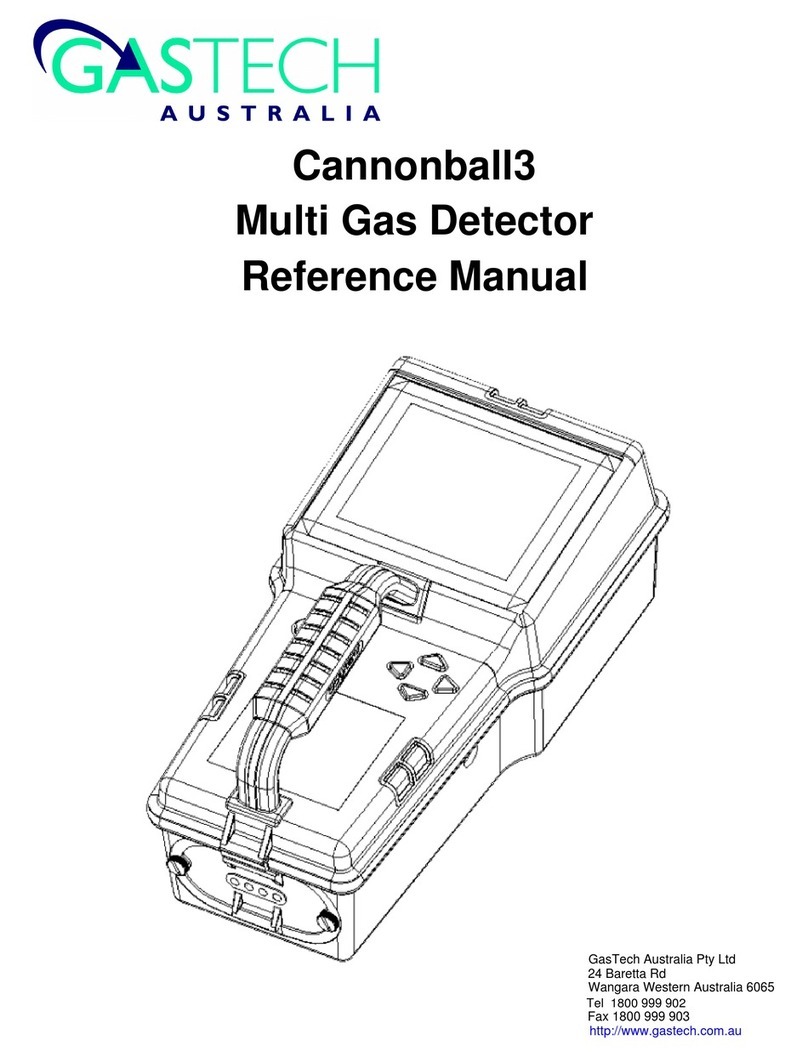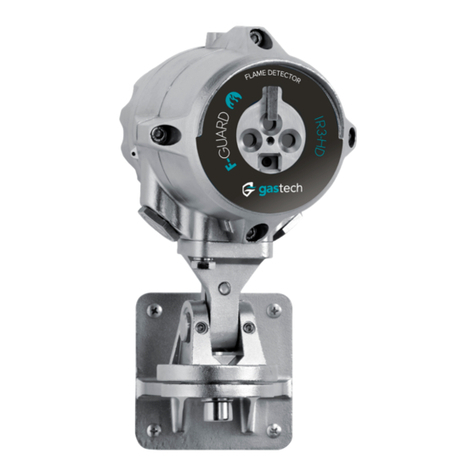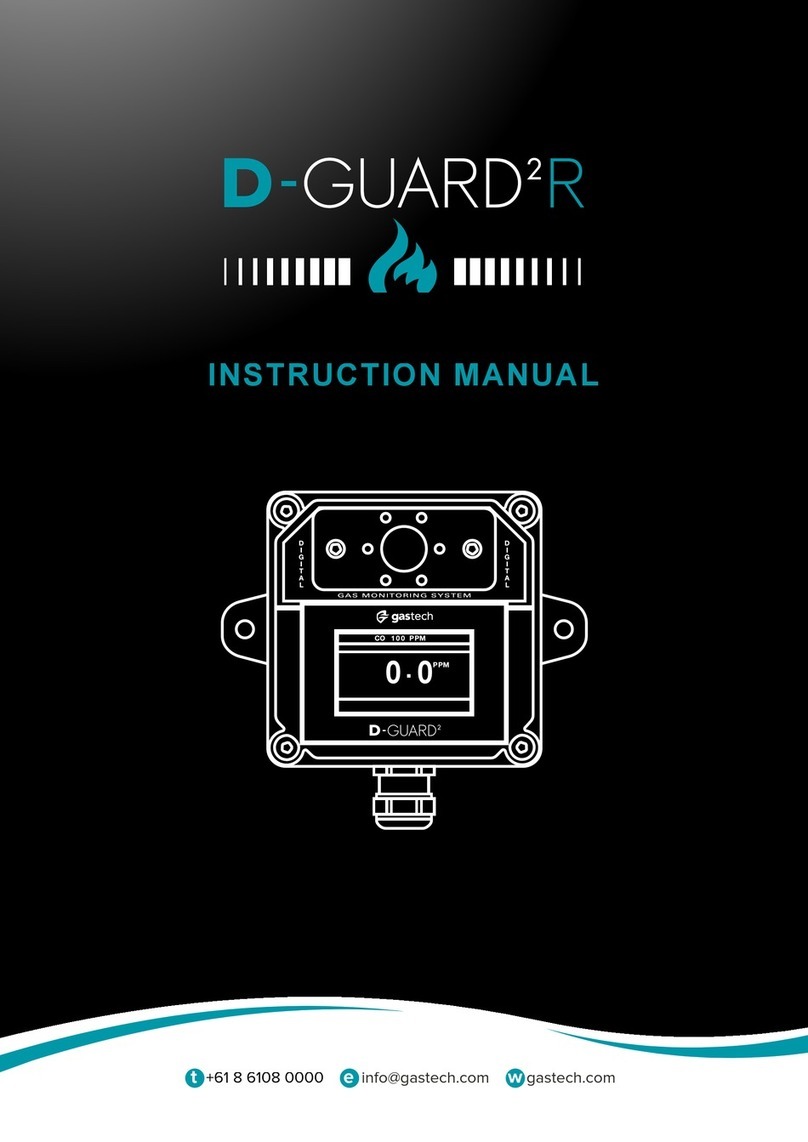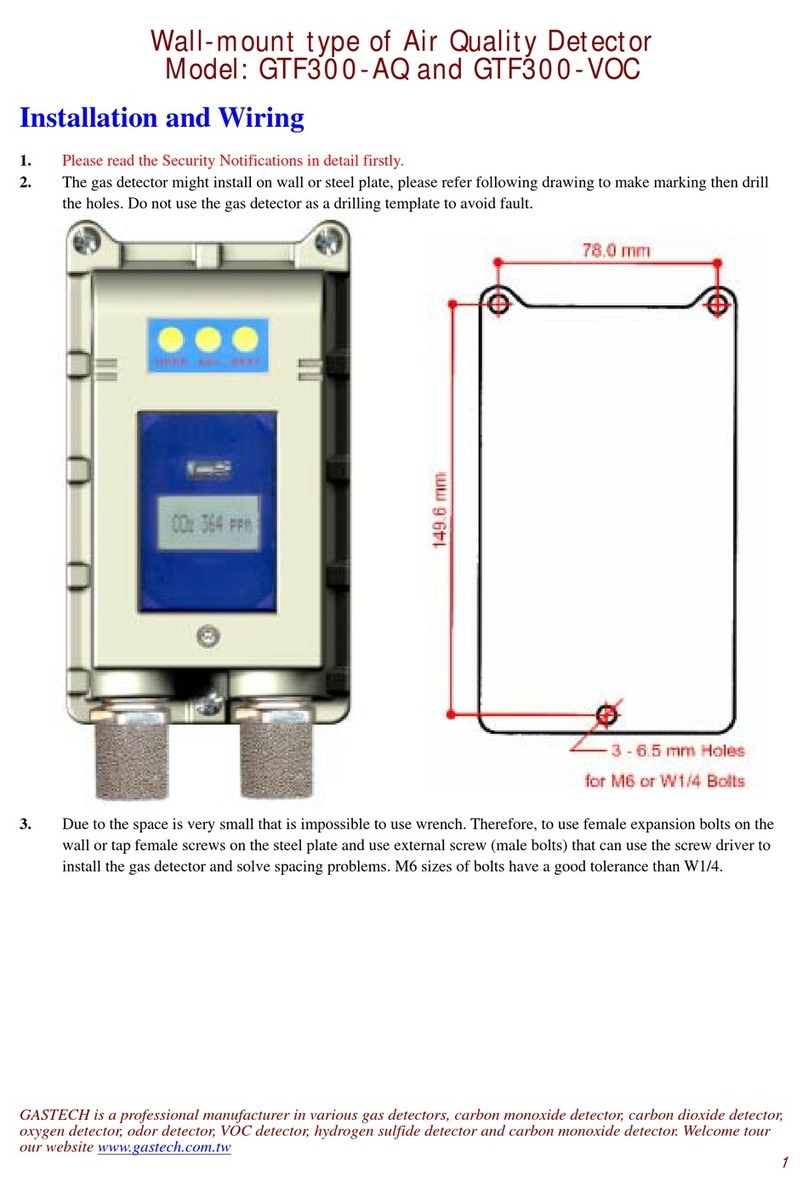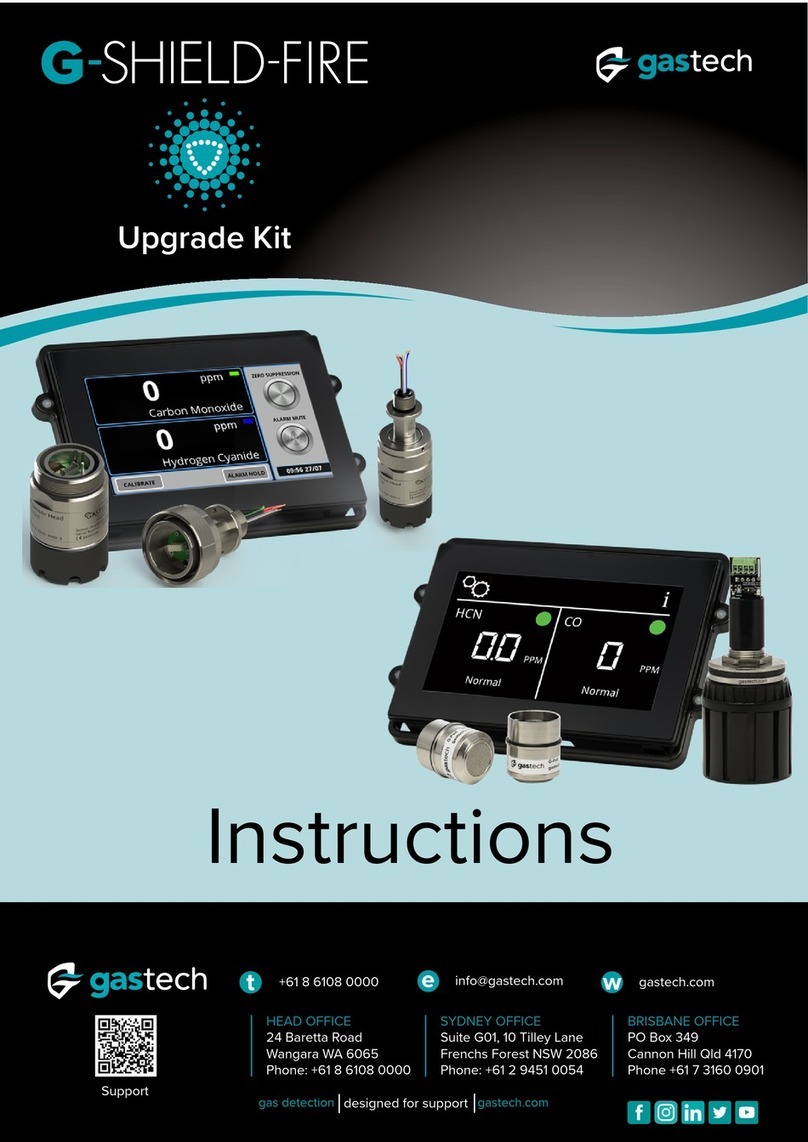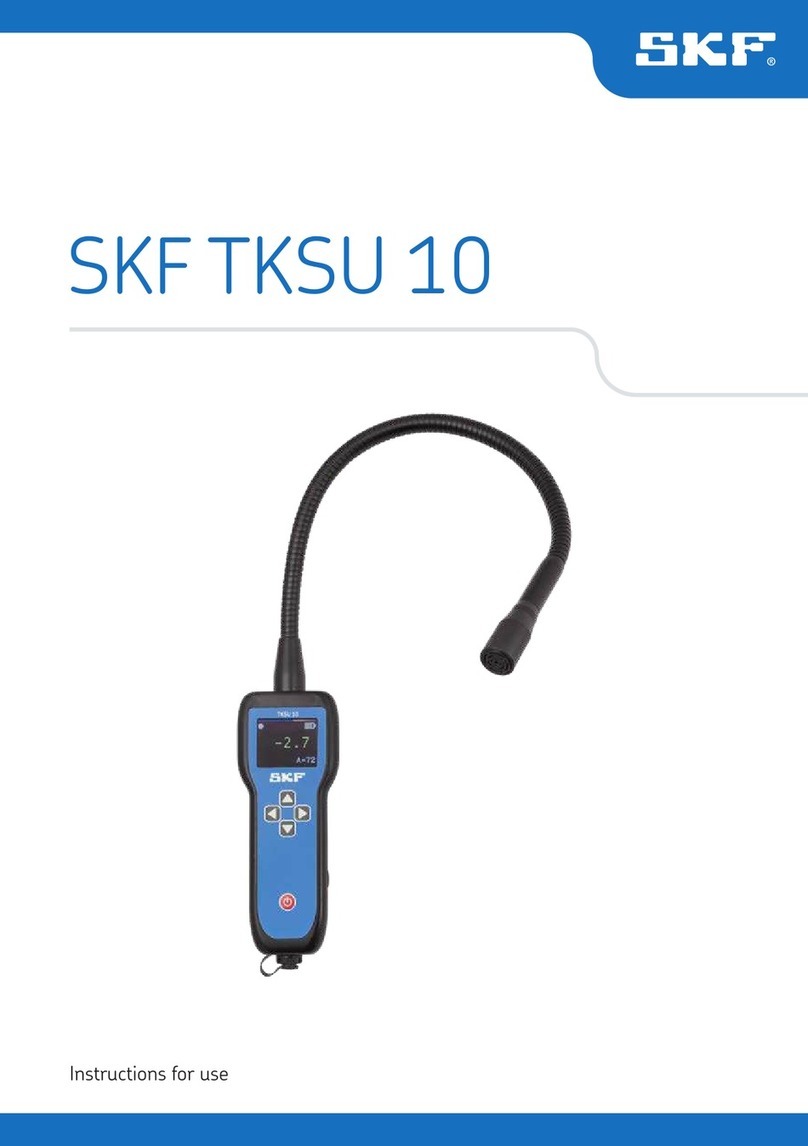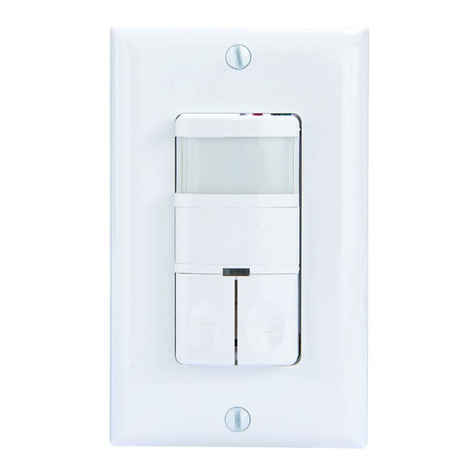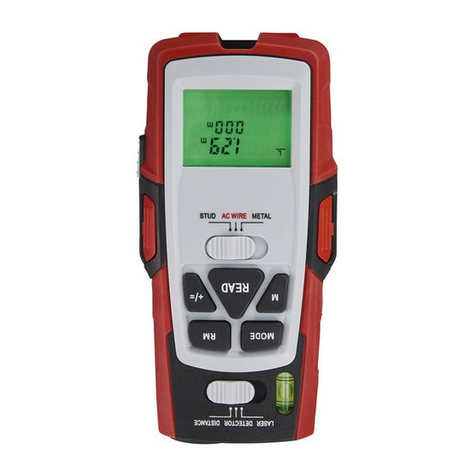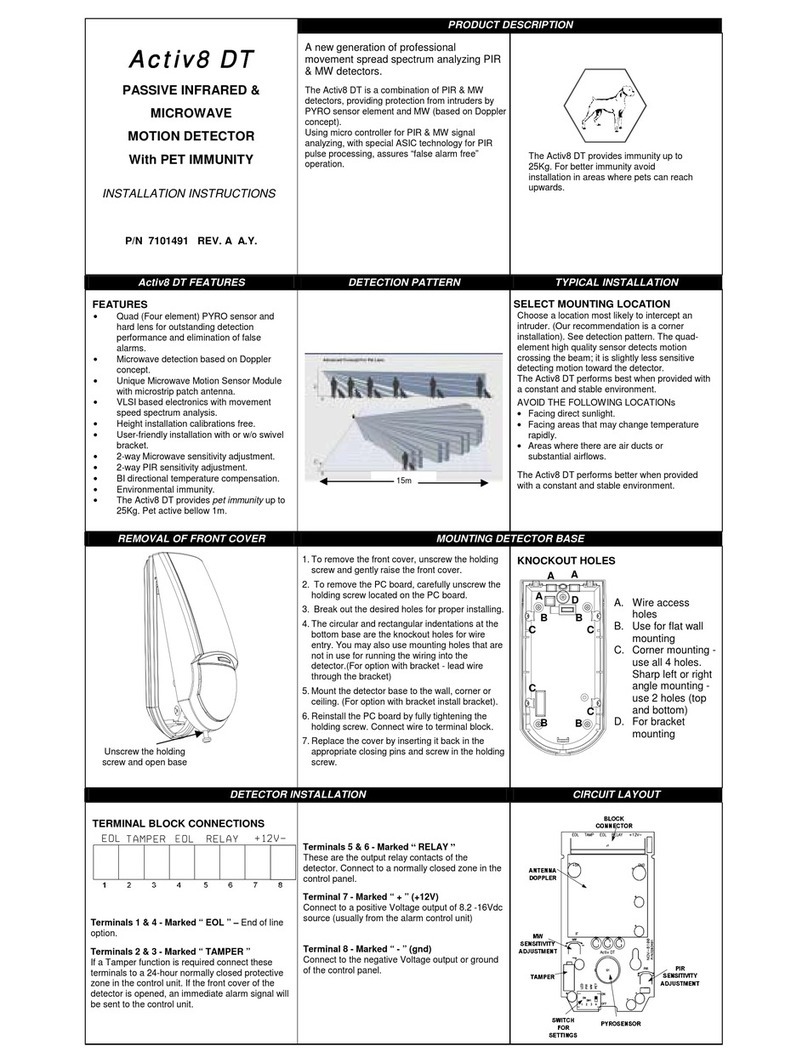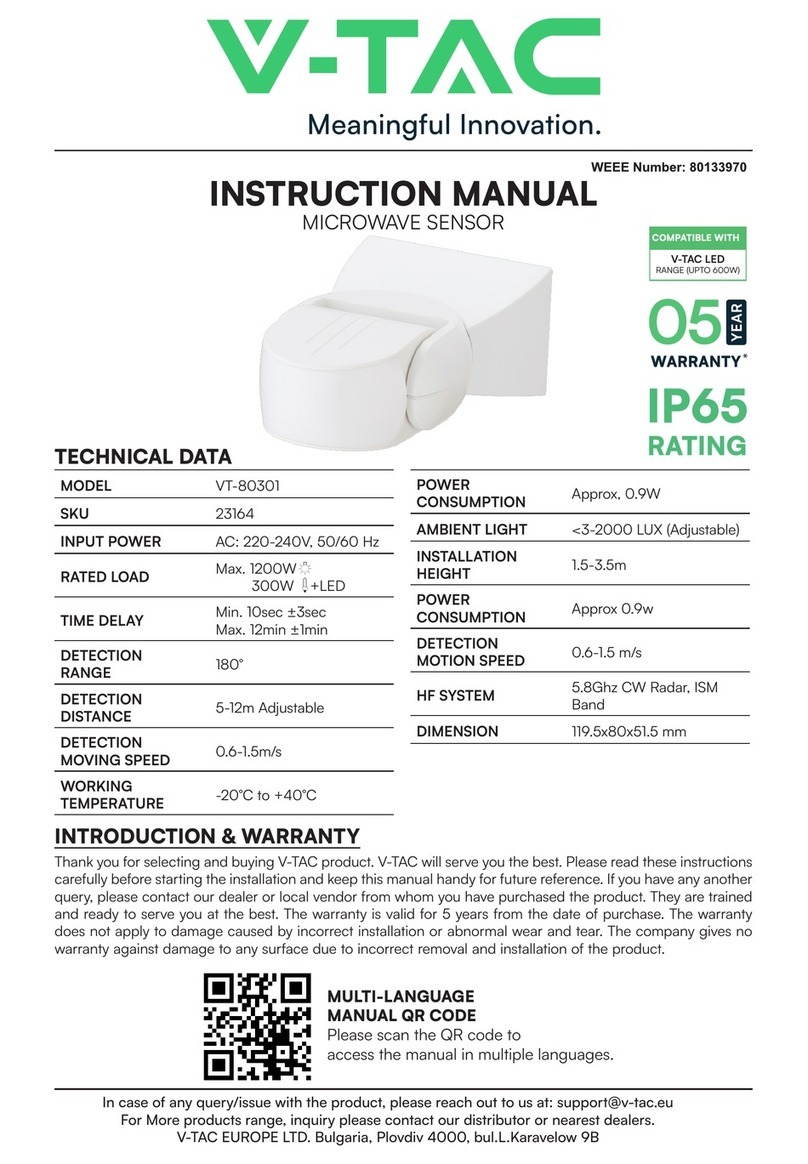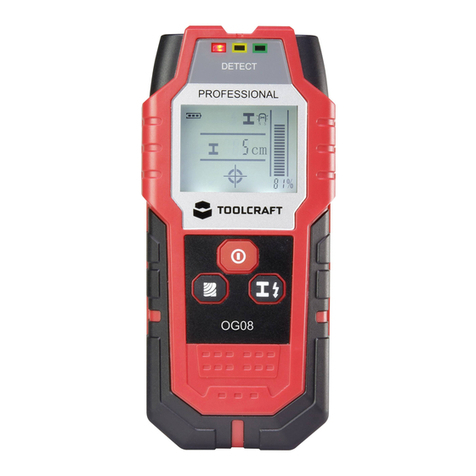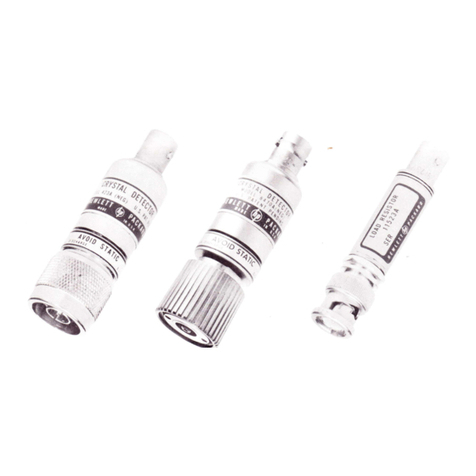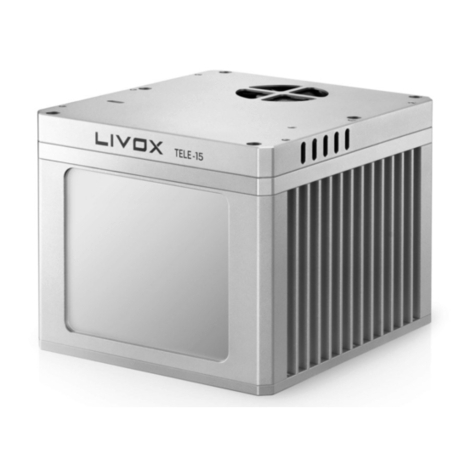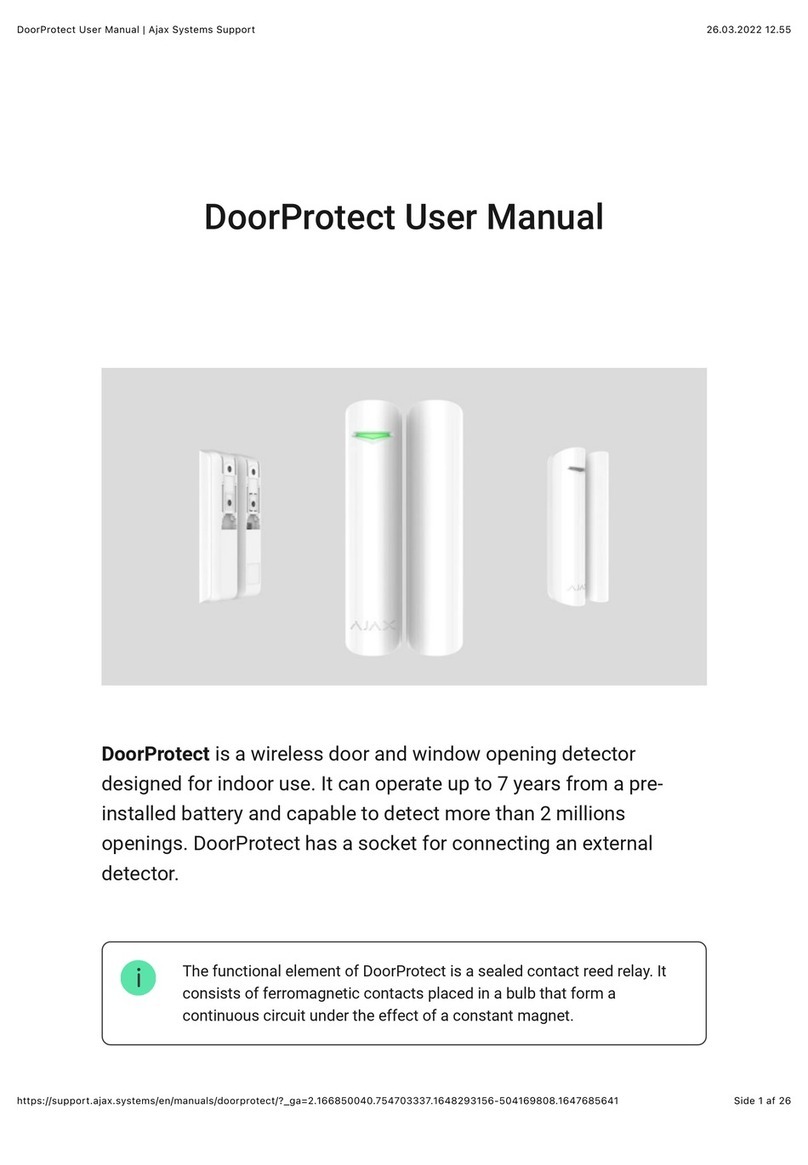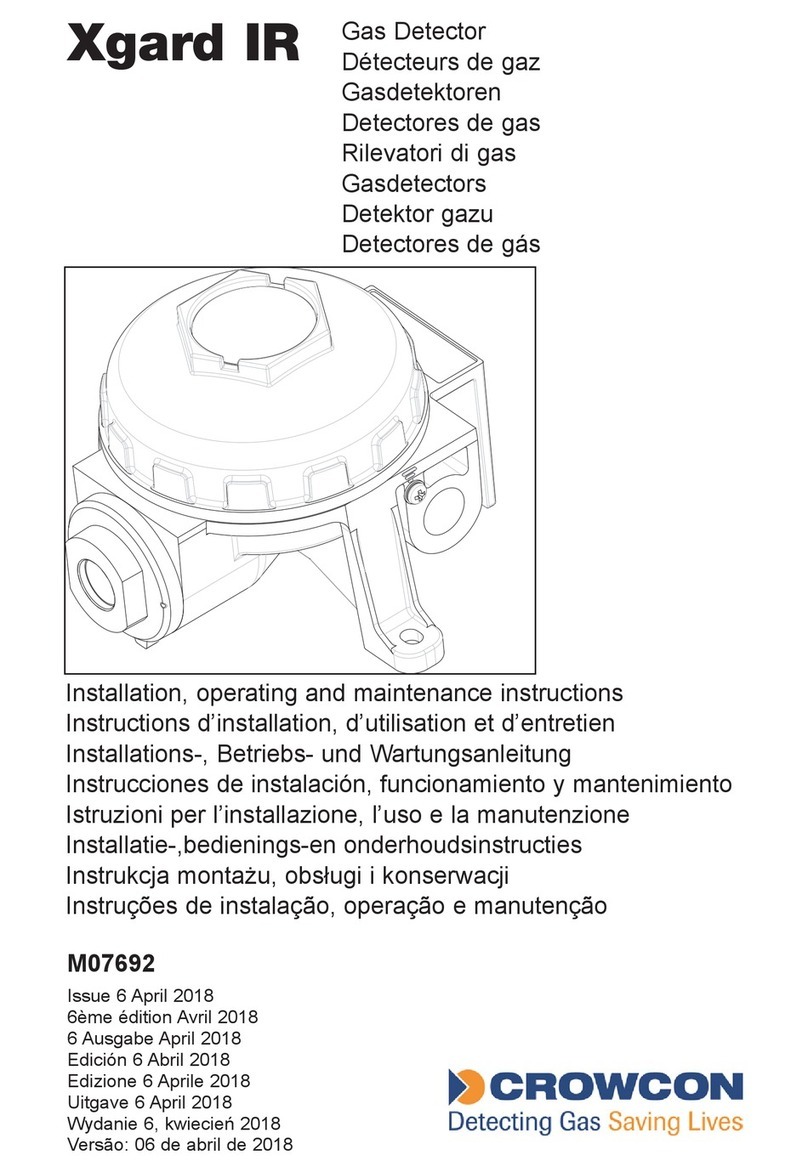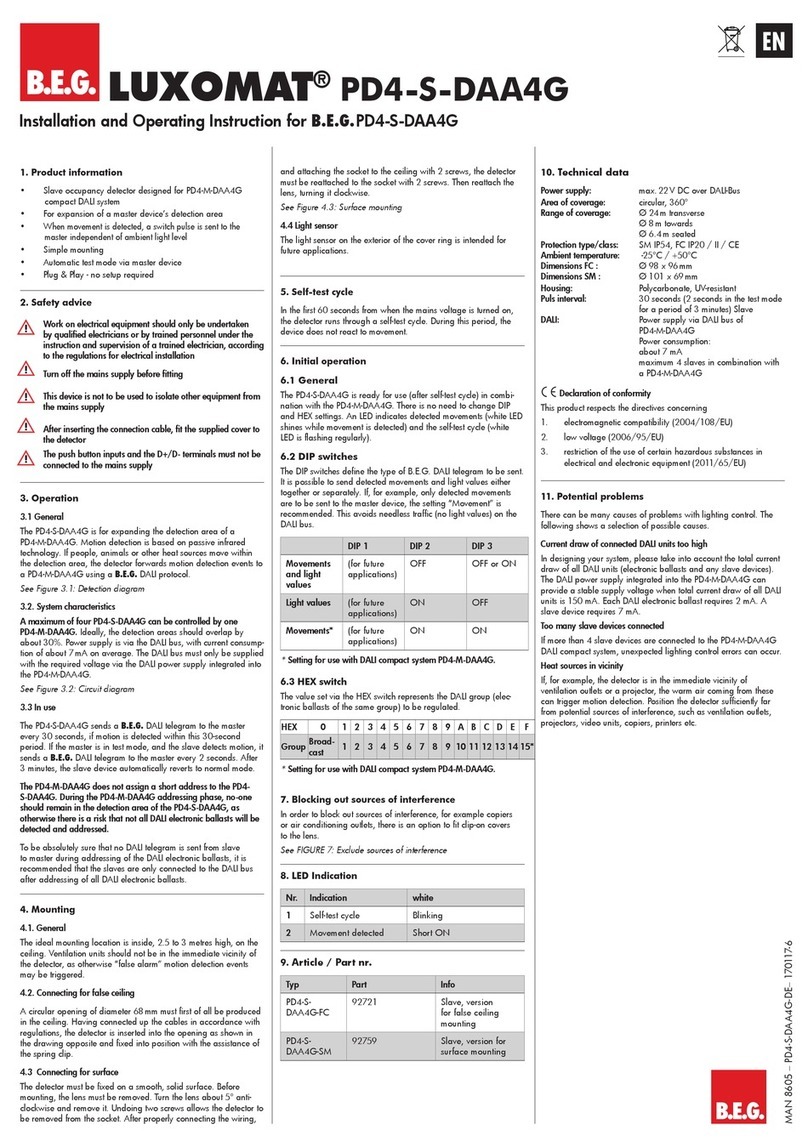GasTech ToxiPro User manual

ToxiP ro
®
S ing le G a s
D etec tor
R eferenc e M a nua l
GasTech Australia Pty Ltd
24 Baretta Rd
Wangara Western Australia 6065
Tel 1800 999 902
Fax 1800 999 903
http://www.gastech.com.au

1
THE TOXIPRO®PERSONAL PORTABLE GAS DETECTORS HAVE
BEEN DESIGNED FOR THE DETECTION AND MEASUREMENT OF
POTENTIALLY HAZARDOUS ATMOSPHERIC CONDITIONS.
IN ORDER TO ASSURE THAT THE USER IS PROPERLY WARNED OF
POTENTIALLY DANGEROUS ATMOSPHERIC CONDITIONS, IT IS
ESSENTIAL THAT THE INSTRUCTIONS IN THIS REFERENCE
MANUAL BE READ, FULLY UNDERSTOOD, AND FOLLOWED.
ToxiPro®Reference Manual
Sperian Instrumentation Part Number 13-264
Version 2.01
Copyright 2008
by
Sperian Protection Instrumentation, LLC
Middletown, Connecticut 06457
All rights reserved.
No page or part of this operation manual may be reproduced in
any form without written permission of the copyright owner
shown above.
Sperian Instrumentation reserves the right to correct
typographical errors.

2
Table of Contents
Operating Temperature Range ............................................................................ 3
Certifications ......................................................................................................... 3
ATEX Label Requirement ..................................................................................... 3
Warnings and Cautions ........................................................................................ 4
A. Signal Words....................................................................................................................4
B. Warnings ..........................................................................................................................4
1. Overview......................................................................................................... 5
1.1 Methods of sampling....................................................................................................5
1.2 Sensors ........................................................................................................................5
1.2.1 ToxiPro sensor ranges.............................................................................................5
1.2.2 ToxiPro O2sensor ranges .......................................................................................5
1.2.3 ToxiPro O2warm-up phase .....................................................................................5
1.3 Alarm and warning logic ..............................................................................................5
1.3.1 Gas alarms...............................................................................................................5
1.3.2 Calibration and bump test due notices ....................................................................5
1.3.3 Low battery alarms ..................................................................................................5
1.3.4 Missing sensor during startup..................................................................................5
1.3.5 Corrupt memory.......................................................................................................5
1.4 Functions......................................................................................................................6
1.4.1 Security beep ...........................................................................................................6
1.4.2 Latching alarms .......................................................................................................6
1.4.3 Silence warning alarms............................................................................................6
1.5 IQ Dock Compatibility ..................................................................................................6
1.6 Design components .....................................................................................................6
1.7 Standard accessories ..................................................................................................6
1.8 Value pack kits.............................................................................................................6
2. Field Operation .............................................................................................. 6
2.1 Turning the ToxiPro on ................................................................................................6
2.1.1 Calibration due lockout ............................................................................................8
2.2 Backlight.......................................................................................................................8
2.3 Functions......................................................................................................................8
2.4 Calibration and bump test due notices ........................................................................8
2.5 Low battery alarms.......................................................................................................9
2.6 Turning the ToxiPro off ................................................................................................9
2.7 Always On Mode..........................................................................................................9
2.7.1 Turning Off in Always On Mode...............................................................................9
2.8 Sampling ......................................................................................................................9
2.8.1 Sample draw kit usage ............................................................................................9
3. Calibration.................................................................................................... 10
3.1 Verification of accuracy..............................................................................................10
3.1.1 Verifying accuracy and response: ToxiPro O2.......................................................10
3.1.2 Verifying accuracy: ToxiPro with toxic gas sensor................................................10
3.2 Effect of contaminants on ToxiPro sensors ...............................................................10
3.2.1 Effects of contaminants on O2sensors .................................................................10
3.2.2 Effects of contaminants on toxic gas sensors .......................................................11
3.3 Fresh air/zero calibration ...........................................................................................11
3.4 Functional (bump) testing (toxic sensor versions).....................................................11
3.5 Span Calibration (toxic sensor versions)...................................................................12
3.6 Failure to calibrate .....................................................................................................12
3.6.1 Fresh air/zero calibration failure ............................................................................12
3.6.1.1 Causes of fresh air/zero calibration failures..................................................12
3.6.1.2 Forced fresh air/zero calibration....................................................................13
3.6.2 Span calibration failure ..........................................................................................13
3.6.2.1 Sensor out of range (no CAL) .......................................................................13
3.6.2.2 No gas ...........................................................................................................13

3
3.6.2.3 Causes for span cal failure............................................................................13
3.7 Fresh air/zero calibration in a contaminated atmosphere .........................................13
4. Maintenance ................................................................................................. 13
4.1 Replacing batteries ....................................................................................................13
4.2 Replacing sensors .....................................................................................................14
4.3 Proper Cleaning .........................................................................................................15
4.4 Storage.......................................................................................................................15
5. PC-Instrument Communications ................................................................ 15
5.1 Event logging .............................................................................................................15
5.2 Instrument firmware Upgrades ..................................................................................15
5.3 Initiating communications ..........................................................................................15
6. Exploded view and basic parts list............................................................. 15
Appendices.......................................................................................................... 16
Appendix A: Sensor Cross-Sensitivity Chart..........................................................................16
Appendix B: Replacement Sensor List ..................................................................................16
Appendix C: Calibration Frequency Recommendation.........................................................17
Sperian Instrumentation Warranty Gas Detection Products........................... 18
Operating Temperature Range
The safe operating temperature range of the gas detector is printed
on the back label of the instrument. Use of Sperian Gas Detectors outside of the
instrument’s specified operating temperature range may result in inaccurate and
potentially dangerous readings.
Certifications
The ToxiPro®carries the following certifications:
UL and c-UL, Class I, Division 1, Groups A,B,C,D, Temp Code T4.
UL Class II, Division 1, Groups E,F,G
CSA Class I, Division 1, Groups A,B,C,D, Temp Code T4.
CSA Class II, Division 1, Groups E,F,G
ATEX Certification:
II 2 G EEx ia IIC T4
UL International DEMKO A/S 04 ATEX 0327520
IECEx Ex ia IIC T4
CQST (China)
ATEX Label Requirement

4
Warnings and Cautions
A. Signal Words
The following signal words, as defined by ANSI Z535.4-1998, are used in the ToxiPro
Operator’s Guide.
indicates an imminently hazardous situation which, if not avoided,
will result in death or serious injury.
indicates a potentially hazardous situation which, if not avoided,
could result in death or serious injury.
indicates a potentially hazardous situation, which if not avoided, may
result in moderate or minor injury.
CAUTION used without the safety alert symbol indicates a potentially hazardous
situation which, if not avoided, may result in property damage.
B. Warnings
1. ToxiPro personal, portable gas detectors have been designed for
the detection of either oxygen deficiencies or specific toxic gas accumulations. An
alarm condition indicates the presence of a potentially life-threatening hazard and
should be taken very seriously.
2. In the event of an alarm condition it is important to follow
established procedures. The safest course of action is to immediately leave the
affected area, and to return only after further testing determines that the area is
once again safe for entry. Failure to immediately leave the area may result in
serious injury or death.
3. Use only Duracell Ultra #CR2, Energizer #1CR2 (EL1CR2), Sanyo
#CR2 or Panasonic #CR2 in the ToxiPro.
4. The accuracy of ToxiPro instruments equipped with toxic gas
sensors should be checked periodically with known concentration calibration gas.
Failure to check accuracy can lead to inaccurate and potentially dangerous
readings. The ToxiPro O2should be periodically calibrated in fresh air.
5. A sensor that cannot be calibrated or is found to be out of
tolerance must be replaced immediately. An instrument equipped with a toxic gas
sensor that fails calibration may not be used until testing with known concentration
test gas determines that accuracy has been restored, and the instrument is once
again fit for use. Instruments equipped with an oxygen sensor that fail calibration
may not be used until testing with fresh air determines that accuracy has been
restored and the instrument is once again fit for use.
6. Do not reset the calibration gas concentration setpoints in the
ToxiPro unless the concentrations of your calibration gas differ from the
concentrations of the calibration gas that is normally supplied by Sperian
Instrumentation for use in calibrating the ToxiPro.
7. Use of non-standard calibration gas and/or calibration kit
components when calibrating the ToxiPro can lead to dangerously inaccurate
readings and may void the standard Sperian Instrumentation warranty.
Sperian Instrumentation offers calibration kits and long-lasting cylinders of test gas
specifically developed for easy calibration. Customers are strongly urged to use
only Sperian Instrumentation calibration materials when calibrating the ToxiPro.
8. Substitution of components may impair intrinsic safety.
9. For safety reasons the ToxiPro must be operated by qualified
personnel only. Read, understand and follow the directions set forth in this
reference manual before operating the ToxiPro.
10. The ToxiPro has been tested for intrinsic safety in Explosive
Gas/AIR (max. 21.0% O2).

5
1. Overview
The ToxiPro is a single sensor gas detector
that can be configured to detect either oxygen
(O2) or one of a variety of toxic gases. The
ToxiPro’s sensor type is shown on the front of
the instrument and is also shown on the
display during the start up sequence. The
ToxiPro includes numerous features designed
to meet specific user requirements.
Note: Early production runs of the oxygen
version of the ToxiPro were referred to as
the “OxyPro”. The instructions contained
in this manual that refer to the ToxiPro
oxygen (O2) are also valid for the OxyPro
with similar instrument firmware.
1.1 Methods of sampling
The ToxiPro may be used in diffusion mode,
or with the manual sample draw kit that is
available separately. In either mode, the
atmosphere must reach the sensor for the
instrument to register a reading. In diffusion
mode, the atmosphere reaches the sensor by
diffusing through the sensor port on the front
of the instrument. Normal air movements are
enough to carry the sample to the sensor.
During remote sampling, the gas sample is
drawn into the sensor compartment through
the probe assembly and a length of tubing.
See section 2.8 for more details on
sampling the atmosphere.
1.2 Sensors
All versions of the ToxiPro except the O2
model use an electrochemical toxic gas
sensor. The ToxiPro O2uses a galvanic
oxygen sensor. Both types of sensor have
been designed to minimize the effects of
common interfering gases. These sensors
provide accurate, dependable readings for
gases commonly encountered in industrial
applications.
A sensor cross sensitivity chart is provided in
Appendix A at the back of this manual.
1.2.1 ToxiPro sensor ranges
Specific toxic sensor ranges and resolutions
are provided in the sensor replacement chart
in Appendix B.
1.2.2 ToxiPro O2sensor ranges
The oxygen sensor used in the ToxiPro O2
has a range of 0-30% by volume.
1.2.3 ToxiPro O2warm-up phase
The ToxiPro O2requires a one-time, 15-
minute warm-up phase prior to initial
activation. See section 2.1 for further details.
1.3 Alarm and warning logic
1.3.1 Gas alarms
ToxiPro gas alarms are user-adjustable and
may be set anywhere within the range of the
specific sensor. When an alarm set point is
exceeded a loud audible alarm sounds, and
the bright red LED alarm light flashes.
Two oxygen alarm set points have been
provided for ToxiPro O2instruments. The
danger alarm is sounded for oxygen
deficiency and the warning alarm is sounded
for oxygen enrichment.
ToxiPro instruments equipped with a toxic gas
sensor have up to four alarm set points:
Warning, Danger, TWA (Time Weighted
Average) (if enabled) and STEL (Short Term
Exposure Limit) (if enabled).
Note: In the standard ToxiPro
configuration with toxic gas sensors, the
STEL and TWA alarms are not enabled.
The STEL and TWA alarms may be
enabled at the factory or through BioTrak
software. Call Sperian Instrumentation for
more details.
1.3.2 Calibration and bump test due
notices
The ToxiPro includes bump test and
calibration due notices.
For more information on the calibration
due notices, see section 2.4 below.
1.3.3 Low battery alarms
The ToxiPro is designed with two battery
warning alarms that are activated when the
battery voltage is reduced to specific levels.
For more details on the battery alarm, see
section 2.5 below.
1.3.4 Missing sensor during startup
If the ToxiPro fails to
detect a sensor during
startup, it will show “F 1”
with the caution symbol
and then shut itself off.
For more details, see section 2.1.
1.3.5 Corrupt memory
The ToxiPro continuously
monitors its onboard
memory. If the instrument
determines that the
memory is corrupt, it will
display “F 4” and proceed to shut itself off.
If “F 4” is displayed, contact Sperian
Instrumentation for further details.

6
1.4 Functions
1.4.1 Security beep
The ToxiPro includes a security beep that can
be enabled or disabled with BioTrak software
through the PC’s IrDA port. If the security
beep is enabled, the ToxiPro will emit a short
beep coupled with an LED flash at a specific
interval to remind the user that the instrument
is active.
1.4.2 Latching alarms
The ToxiPro includes latching alarms that can
be enabled or disabled with BioTrak software
through the PC’s IrDA port. With the alarm
latch enabled, the audible and visible alarms
will continue to sound even after the
atmospheric hazard has cleared. To turn the
alarm off once the hazard is no longer
present, simply press the MODE button.
1.4.3 Silence warning alarms
The ToxiPro’s audible and vibrating (if so
equipped) alarms can be turned off during an
alarm condition by pressing the MODE button
if this function has been enabled with BioTrak
software. The visual warning alarm light and
readings will continue to indicate the alarm.
1.5 IQ Dock Compatibility
The ToxiPro must be equipped with
instrument firmware version 4.30 or higher to
be compatible with the IQ Express Docking
Station. The IQ Express Dock is an
automatic calibration station coupled with a
data management system.
Instrument firmware in the ToxiPro may be
upgraded at any time. See section 5.2
below for details on software upgrades.
1.6 Design components
Case: The instrument is enclosed in a solid
PC (polycarbonate) case with TPE (rubber)
overmold.
Figure 1: Exterior front view.
Front face: The front face of the instrument
houses the LCD display, MODE button,
sensor port, LED alarm and audible alarm
port.
LCD display: The liquid crystal display (LCD)
shows gas readings, messages and other
information. A built-in, manually-activated
backlight allows the display to be read even in
low light conditions.
Visual alarm (LED) / IrDA port: A bright red
LED (Light-Emitting Diode) alarm light
provides a visual indication of the alarm state.
The LED also functions as the IrDA port.
MODE button: The large push-button on the
front of the instrument is called the MODE
button. The MODE button is used to turn the
ToxiPro on and off, to turn on the backlight, to
view the MAX, STEL (if enabled) and TWA (if
enabled) screens and to initiate the automatic
calibration sequences.
Sensor port: The sensor port is located at
the upper left corner of the instrument. A filter
prevents unwanted contaminants from
entering the sensor.
Audible alarm port: A cylindrical resonating
chamber contains the loud audible alarm.
Belt Clip: The belt clip attaches to the bottom
surface of the instrument.
1.7 Standard accessories
Standard accessories with every ToxiPro
include installed sensor and lithium battery,
reference manual and calibration/sample
draw adapter.
Optional accessories include manual sample
draw kit (hand-aspirated), vibrating alarm,
Datalogger Upgrade and BioTrak software kit.
1.8 Value pack kits
ToxiPro value packs include all standard
accessories, plus calibration fittings, 34-liter
cylinder of calibration gas, and fixed flow rate
regulator in a foam-lined, hard-shell carrying
case.
2. Field Operation
Field operation of the ToxiPro is controlled
entirely through the MODE button, which is
located on the front of the instrument.
The MODE button is used to turn the ToxiPro
on and off, to turn on the backlight, to access
MAX, STEL (if enabled) and TWA (if enabled)
gas readings for the current session and to
initiate calibration.
2.1 Turning the ToxiPro on
The ToxiPro is effectively disabled when it
leaves the Sperian Instrumentation factory.
Upon arrival, the ToxiPro’s display will be
blank. The ToxiPro O2will show the negated
horn icon.

7
or
To initialize the instrument, press the MODE
button. ToxiPro O2models will proceed with
a 15-minute countdown while the oxygen
sensor stabilizes.
Note: The 15-minute sensor warm-up
period is only necessary for the initial
start-up of ToxiPro O2models.
→
When the ToxiPro O2warm-up period
concludes, the screen will be completely
blank. ToxiPro models equipped with a toxic
gas sensor do not require an initial warm up
period.
With the blank screen
shown, press and hold
the MODE button for 5
seconds to initiate the
start-up sequence.
At start-up, the ToxiPro will automatically go
through a basic electronic self-test sequence
that will take approximately thirty seconds.
During the self-test sequence, all sections of
the display will be lit, the
display backlight will
momentarily turn on and
the audible alarm will
“chirp”.
If the instrument fails to
detect the sensor during
startup, “F 1” will be
displayed with the caution
symbol following the
display test screen.
If “F 1” is shown, the instrument will
automatically shut down in approximately 5
seconds. See Section 4.2
of this manual for
instructions on accessing
the sensor compartment.
Once the ToxiPro
recognizes the sensor, it
will display the software version.
The serial number screens will then be
shown: Note that the 6 digit serial number
can not fit on a single screen, so it is shown
on two screens. In this case, the instrument
serial number is 481098.
→
Datalogging versions will
then show the “dL” screen.
Once the sensor is
recognized, the instrument
will display the sensor
type.
The warning alarm level
will then be displayed,
followed by the danger
alarm level. During the
display of the warning
alarm level, the LED alarm
light will be flashed twice and the audible
warning alarm will be sounded twice.
During the display of the danger alarm level,
the LED visual alarm will be flashed twice and
the audible danger alarm will be sounded
twice. The frequency of the audible danger
alarm is higher than the frequency of the
audible warning alarm.
→
For ToxiPro instruments with a toxic sensor
and with the STEL and TWA alarms enabled,
the ToxiPro will briefly show the STEL and
TWA alarm levels.
→
If the calibration due reminder is enabled and
calibration is due, the following screens will
be shown.
→
Press the MODE button to acknowledge the
calibration due reminder. If the instrument
shuts off when the MODE button is pressed
with “cal due shown”, then the ToxiPro is
configured with calibration due lockout
enabled.
See section 2.1.1 below for more details
on the calibration due lockout function.
The Calibration Due Reminder and Lockout
functions may be enabled or disabled with
BioTrak Software.
The current gas readings screen will then be
shown. Toxic sensor models should show 0 if

8
the instrument is located in fresh air. Oxygen
sensor models should show 20.9 in fresh air.
or
2.1.1 Calibration due lockout
When the ToxiPro’s calibration due lockout
function is enabled and calibration is due, the
calibration due warning will be shown at
instrument start up and can not be bypassed.
The instrument must be calibrated
immediately before it will show any gas
readings. The calibration may be performed
manually, or by placing it in an IQ Express
Dock. Upon successful calibration, the
ToxiPro will proceed to the current gas
readings screen.
The calibration due lockout function can be
enabled or disabled with BioTrak software.
2.2 Backlight
The ToxiPro includes a backlight that is
automatically turned on during an alarm
condition. The backlight can also be
manually activated while the current gas
reading is displayed by pressing the MODE
button once. When manually activated, the
backlight will automatically turn itself off in
about twenty seconds. If activated by an
alarm condition, the backlight will remain on
until the instrument is no longer in alarm.
2.3 Functions
From the current gas
reading screen, press the
MODE button once to
activate the backlight.
Press MODE again to
scroll through the screen options.
Once the backlight has been lit, press MODE
once more to view the MAX gas values
screen. The MAX figure represents the
highest gas value reading that has been
recorded by the instrument during the current
operating session. ToxiPro O2models will
sequentially display both the highest and the
lowest readings that have been recorded by
the instrument in the current operating
session.
From the MAX screen, press the MODE
button to view the time screen. A dot below
the colon between the hours and the minutes
digits indicates afternoon/evening hours (pm).
10:45 am 10:45 pm
If the STEL (Short Term Exposure Limit)
alarm is enabled, press the MODE button
once to view the STEL reading. The STEL
value displayed represents
the average value of the
instrument readings for the
target gas for the most
recently completed 15
minutes of operation.
If the TWA (Time Weighted Average) alarm is
enabled, press the MODE button once more
to view the current TWA value. TWA values
are calculated by taking the sum of the
instrument readings for the
target gas for the current
operating session in terms
of parts-per-million-hours
and dividing by an eight-
hour period.
Note: Due to the nature of the TWA
calculation, the TWA value can
accumulate over time and may cause the
instrument to go into alarm. Sperian
Instrumentation recommends resetting the
TWA value at the beginning of any work
shift by turning off the instrument and
then turning it back on again.
Press the MODE button again to return to the
current gas readings screen.
2.4 Calibration and bump test due
notices
When the calibration due notice is enabled
and the ToxiPro is due for fresh air calibration
“0-CAL will be displayed at the bottom of the
current gas readings
screen along with the
triangular warning symbol.
When the calibration due
notice is enabled and the
ToxiPro is due for span
calibration the calibration
bottle icon will be displayed
at the bottom of the current
gas readings screen along
with the warning symbol.
The bump test due notice
is designed for instruments
that are processed in an IQ
Express Dock. When the
bump test due notice is
enabled and the ToxiPro is
due for a bump test, the calibration bottle
icon will be displayed at the bottom of the

9
current gas readings screen without the
triangular warning symbol.
Note: If an IQ Express Dock is
unavailable, a span calibration will also
reset the bump test due notice.
2.5 Low battery alarms
When there are less than
7 days of battery life
remaining, the low battery
icon will be lit.
When there are less than
8 hours of battery life
remaining, the triangular
warning symbol on the
LCD will also be shown.
When the battery reaches
a level where it can no
longer power the
instrument, the ToxiPro will
sound the danger alarm
while displaying the
danger, caution and
battery icons.
Press MODE to turn the instrument off. The
battery must be replaced before the
instrument can be used again. If the MODE
button is not pressed, the instrument will
remain in alarm for as long as it can before
shutting itself off.
2.6 Turning the ToxiPro off
To turn the ToxiPro off,
press and hold the MODE
button down until the
instrument chirps three
times and OFF is
displayed.
Once OFF is displayed, release the MODE
button. The instrument has been successfully
turned off when the display goes blank.
If Always On Mode is enabled see section
2.7.1 for instructions for of turning off the
ToxiPro
2.7 Always On Mode
The ToxiPro may be configured so that it may
not be turned off with the MODE button. In
Always On Mode, the MODE button is used to
reset the MAX, STEL and
TWA calculations. Press
and hold the MODE button
until the instrument chirps
three times and “on” is
displayed.
After the “on” screen, the ToxiPro will proceed
through the standard startup sequence until
the current gas readings screen is shown.
MAX, STEL and TWA calculations will be
reset.
Always On Mode may be enabled or disabled
with BioTrak software.
Note: The ToxiPro must be turned off to
replace the battery. See section 2.7.1.
2.7.1 Turning Off in Always On Mode
BioTrak software must be used to turn the
ToxiPro off when it is in Always on Mode.
BioTrak is available at:
http://www.biodownloads.com
1. Open BioTrak and select ToxiPro.
2. Select “Configure” in the software.
3. Hold the MODE button down for about 10
seconds until IrDA is shown and establish
the connection with the PC.
4. The Turn Off option appears at the bottom
left of every page in the configuration
window. Click the Turn Off button.
2.8 Sampling
The ToxiPro may be used in either diffusion
or sample-draw mode. In either mode, the
gas sample must enter the sensor
compartment for the instrument to register a
gas reading.
In diffusion mode, the atmosphere reaches
the sensor by diffusing through the sensor
port on the front of the instrument. Normal air
movements are enough to carry the sample to
the sensor. The sensor reacts quickly to
changes in the concentration of the gas being
measured.
It is also possible to use the ToxiPro to
sample remote locations with the hand-
aspirated sample-draw kit that is available
separately. During remote sampling, the gas
sample is drawn into the sensor compartment
through the probe assembly and a length of
tubing.
2.8.1 Sample draw kit usage
1. Connect the shorter section of tubing
from the squeeze bulb to the sample
draw adapter. Then connect the longer
section of tubing from the squeeze bulb
to the sample probe.
2. Slide the sample draw adapter into the
sensor port on the ToxiPro and secure
it.
3. Cover the end of the sample draw
probe assembly with a finger, and
squeeze the aspirator bulb. If there are
no leaks in the sample draw kit
components, the bulb should stay
deflated for a few seconds.
4. Insert the end of the sample probe into
the location to be sampled.
5. Squeeze the aspirator bulb several
times to draw the sample from the

10
remote location to the sensor
compartment. Allow one squeeze of
the bulb for every one foot of sampling
hose for the sample to reach the
sensors. Continue to squeeze the bulb
for an additional 45 seconds or until
readings stabilize.
6. Note the gas measurement readings.
CAUTION: Hand aspirated remote
sampling only provides continuous gas
readings for the area in which the probe is
located when the bulb is being
continuously squeezed.
Note: Each time a reading is desired, it is
necessary to squeeze the bulb a sufficient
number of times to bring a fresh sample to
the sensor compartment and to continue
to squeeze the bulb until readings
stabilize.
3. Calibration
The ToxiPro features fully automated fresh
air/zero and span calibration functions. The
MODE button is used to initiate the automatic
calibration sequence. Calibration
adjustments are made automatically by the
instrument.
3.1 Verification of accuracy
3.1.1 Verifying accuracy and response:
ToxiPro O2
To verify the accuracy of the ToxiPro O2, take
the ToxiPro O2to an area where the
atmosphere is known to be fresh and check
the readings. If the readings differ from those
expected in fresh air (oxygen monitors should
read 20.9% in fresh air), then a fresh air/zero
calibration adjustment must be made as
discussed below in section 3.3. If fresh air is
not available, see section 3.7 below for
instructions for calibrating the ToxiPro O2in
contaminated air.
Sperian Instrumentation also recommends
that the response of the oxygen sensor be
regularly verified by any of these methods:
•Expose the O2sensor to a known
concentration of gas containing less than
19.0% oxygen. If the descending oxygen
alarm is set to 19.5% the instrument
should go into alarm a few seconds after
the gas reaches the sensor face.
•Process the ToxiPro O2 in an IQ Express
Dock that has a cylinder of calibration gas
containing 18.0% oxygen (or less)
connected to the gas port and proceed
with the oxygen bump test.
•Breath test: Hold your breath for 10
seconds, then slowly exhale directly onto
the face of the sensor (in the same way
you would to fog up a piece of glass). If
the descending oxygen alarm is set to
19.5%, the instrument should go into
alarm after a few seconds.
3.1.2 Verifying accuracy: ToxiPro with
toxic gas sensor
Verification of accuracy is a two-step
procedure for ToxiPro instruments equipped
with a toxic gas sensor:
Step one is to take the ToxiPro to an area
where the atmosphere is known to be fresh
and check the readings. If the readings differ
from those expected in fresh air (instruments
equipped with a toxic sensor should read 0
PPM in fresh air), then a fresh air calibration
adjustment must be made as discussed
below in section 3.3.
Step two is to test sensor response by
exposing the sensor to a test gas of known
concentration. This is known as a functional
(bump) test. Readings are considered to be
accurate when the display is between 90%
and 120% of the expected values as given on
the calibration gas cylinder. If readings are
accurate, there is no need to adjust your gas
detector. See section 3.4 for further details
concerning the functional/bump test.
If the readings are inaccurate, the instrument
must be span calibrated before further use as
discussed in section 3.5.
The accuracy of
ToxiPro instruments equipped with toxic
gas sensors should be checked
periodically with known concentration
calibration gas. Failure to check accuracy
can lead to inaccurate and potentially
dangerous readings.
See Appendix C for a discussion of
calibration frequency recommendations.
3.2 Effect of contaminants on ToxiPro
sensors
The atmosphere in which the ToxiPro is used
can have lasting effects on the sensors.
Sensors may suffer losses in sensitivity
leading to degraded performance if exposed
to certain substances.
The ToxiPro O2uses a galvanic oxygen
sensor, while toxic sensor versions of the
ToxiPro use an electrochemical toxic gas
sensor. Different types of sensors use
different detection principles, so the
conditions that affect the accuracy of the
sensors vary from one type of sensor to the
next.
3.2.1 Effects of contaminants on O2
sensors
Oxygen sensors may be affected by
prolonged exposure to "acid" gases such as

11
carbon dioxide. The oxygen sensors used in
Sperian instruments are not recommended for
continuous use in atmospheres containing
more than 25% CO2.
3.2.2 Effects of contaminants on toxic
gas sensors
Sperian Instrumentation’s “substance-
specific” electrochemical sensors have been
carefully designed to minimize the effects of
common interfering gases. “Substance-
specific” sensors are designed to respond
only to the gases that they are supposed to
measure. The higher the specificity of the
sensor, the less likely the sensor will react to
other gases, which may be incidentally
present in the environment. For instance, a
“substance-specific” carbon monoxide sensor
is deliberately designed not to respond to
other gases that may be present at the same
time, such as hydrogen sulfide (H2S) and
methane (CH4).
Although great care has been taken to reduce
cross-sensitivity, some interfering gases may
still have an effect on toxic sensor readings.
In some cases the interference may be
positive and result in readings that are higher
than actual. In other cases the interference
may be negative and produce readings that
are lower than actual and may even cause
the instrument to display negative readings
for the target gas.
See Appendix A for cross-sensitivity data.
3.3 Fresh air/zero calibration
To initiate the fresh air/zero calibration:
1. From the current gas reading screen,
press the MODE button three times within
two seconds to begin the fresh air/zero
calibration sequence. The ToxiPro will
briefly display “CAL” and then begin a 5-
second countdown with the 0-CAL icon lit.
→
2. Press the MODE button before the end of
the 5-second countdown to begin the
fresh air/zero calibration. The fresh
air/zero calibration has been successfully
initiated when the ToxiPro alternates
between the following two screens:
↔
3. For instruments equipped with a toxic gas
sensor, the fresh air/zero calibration is
complete when the instrument begins a
second 5-second countdown for the span
calibration. If span calibration is not
required, allow the countdown to reach 0
without pressing the MODE button. For
further instructions concerning the span
calibration of toxic sensor-equipped
models, proceed to section 3.5.
For ToxiPro O2models, calibration is
complete when the instrument returns to
the current gas readings screen. If the
fresh air/zero calibration attempt fails,
proceed to section 3.6.1.
Fresh air/zero
calibrations may only be performed in an
atmosphere that is known to contain
20.9% oxygen and 0 PPM toxic gas.
Performing the fresh air/zero calibration in
an atmosphere that is not comprised of
20.9% oxygen and 0 PPM toxic gas may
lead to inaccurate and potentially
dangerous readings.
3.4 Functional (bump) testing (toxic
sensor versions)
The accuracy of ToxiPro instruments may be
verified at any time by a simple functional
(bump) test. To perform a functional (bump)
test, do the following:
1. Turn the ToxiPro on and wait at least
three minutes to allow the readings to fully
stabilize. If the sensor has just been
replaced, it must be allowed to stabilize
prior to performing a functional (bump)
test. See section 4.2 for further details.
2. Make sure the instrument is located in
fresh air.
3. Verify that the current gas readings match
the concentrations present in fresh air.
The reading for toxic gases should be 0
parts-per-million (PPM) in fresh air. If the
reading is anything other than 0 PPM
proceed to section 3.3 and perform a
fresh air/zero calibration before
continuing.
4. Apply the calibration
gas as shown in
figure 3.4.
Figure 3.4 Proper
bump-test/span
calibration set-up
for toxic sensor-
equipped
instruments.
Note: ToxiPro instruments equipped with
a chlorine dioxide (ClO2) sensor require a
chlorine dioxide generator as a calibration
gas source.

12
5. Wait for the readings to stabilize. (Forty-
five seconds to one minute is usually
sufficient.)
6. Note the readings. Readings are
considered accurate if they are between
90% and 120% of the expected value. If
the readings are considered accurate,
then the instrument may be used without
further adjustment. If readings are
considered inaccurate, the instrument
must be adjusted using the “span”
calibration procedures discussed in
section 3.5 before further use.
3.5 Span Calibration (toxic sensor
versions)
Span calibration should be performed when a
functional (bump) test has shown that the
instrument’s gas readings are not between
90% and 120% of the expected values as
given on the calibration gas cylinder (as
discussed in section 3.4). Prior to performing
a span calibration, perform a fresh air/zero
calibration as discussed in section 3.3. After
successful completion of the fresh air/zero
calibration, the
instrument will begin a
second five-second
countdown with the
calibration gas bottle
icon highlighted.
1. Press the MODE button before the
countdown is complete to initiate the span
calibration. The display will alternate
between “GAS” and the expected
concentration of calibration gas.
↔
2. Apply calibration gas as shown above in
figure 3.4. Once calibration gas is
detected, the readout will change to show
the gas reading. Note that the negated
horn symbol is shown at lower left to
indicate that the
alarms are not
operating because
the instrument is in
calibration mode.
Note: ToxiPro instruments equipped with
a chlorine dioxide (ClO2) sensor require a
chlorine dioxide generator as a calibration
gas source.
3. The calibration is fully automatic from this
point on. Once the instrument
successfully completes the span
calibration, it will emit three short beeps
and display the maximum span calibration
adjustment value for
two seconds.
Note: The maximum
span calibration adjustment value shown
is an indication of the relative health of the
sensor. As a sensor loses sensitivity, the
maximum adjustment level will approach
the calibration gas concentration, letting
you know when the sensor is losing
sensitivity. Once the maximum span
adjustment descends to within 10% of the
calibration gas concentration, it is time to
order a new sensor.
4. Following successful
calibration, the
instrument will display
the gas reading with
the negated horn icon
until the reading drops
below the alarm threshold.
Disconnect the calibration assembly
immediately after calibration.
Use of non-standard
calibration gas and/or calibration kit
components when calibrating the ToxiPro
can lead to inaccurate and potentially
dangerous readings, and may void the
standard Sperian Instrumentation Gas
Detection Warranty.
3.6 Failure to calibrate
3.6.1 Fresh air/zero calibration failure
In the event of fresh air/zero calibration
failure, the “no” and “CAL” screens will be
alternately displayed as shown below with the
“0-CAL” segment lit. The instrument will then
return to the gas reading screen.
↔
Following a fresh air/zero calibration failure,
the triangular warning
symbol will be lit and the
“0-CAL” indicator will flash
until a successful fresh
air/zero calibration is
performed.
3.6.1.1 Causes of fresh air/zero calibration
failures
Fresh air/zero calibration failures often result
from the attempt to calibrate the instrument in
a contaminated atmosphere.
Fresh air/zero calibration failures in the
ToxiPro O2can also result from an oxygen
sensor that has failed.

13
3.6.1.2 Forced fresh air/zero calibration
If a fresh air/zero calibration fails in an
atmosphere known to be fresh, the ToxiPro
can be forced to fresh air calibrate as follows.
1. Follow instructions 1 and 2 in section 3.3
to begin the fresh air/zero calibration
sequence.
2. As soon as the alternating right and left
0’s are shown on the screen, press and
hold the MODE button.
↔
3. The forced fresh air/zero calibration is
complete when the instrument emits three
short beeps and then moves on to the
span calibration procedure.
Performing the forced
fresh air calibration in a contaminated
atmosphere will lead to inaccurate and
potentially dangerous readings.
3.6.2 Span calibration failure
The ToxiPro is designed to recognize two
distinct types of span calibration failures:
failures that occur due to sensor response
outside the sensor’s normal range for
calibration and failures that occur when the
instrument fails to recognize any calibration
gas whatsoever.
3.6.2.1 Sensor out of range (no CAL)
If the instrument recognizes calibration gas,
but the sensor response is not within the
range to calibrate the instrument, span
calibration will fail and the “no” and “CAL”
screens will be alternately displayed.
↔
After displaying “no” and “CAL” three times,
the instrument will return to the current gas
readings screen and the warning symbol and
the calibration bottle icon
will be shown, which
signifies that the
instrument failed the last
attempt to span calibrate.
Note: If the Calibration
Due Lockout is enabled, the ToxiPro will
turn itself off following a failed calibration
attempt.
3.6.2.2 No gas
In the case of a span calibration failure in
which calibration gas is not detected, the “no”
and “GAS” screens will be alternately
displayed as shown below with the calibration
bottle icon highlighted.
↔
When the instrument returns to the current
gas readings screen, the
warning symbol and the
calibration bottle icon will
be shown, which
signifies that the last
attempt to span calibrate
the instrument has failed.
Note: If the Calibration Due Lockout is
enabled, the ToxiPro will turn itself off
following a failed calibration attempt.
3.6.2.3 Causes for span cal failure
Span calibration failures can be caused by:
1. Expired calibration gas.
2. Calibration gas whose concentration fails
to match the concentration expected by
the instrument.
3. Inappropriate regulator. The ToxiPro
must be calibrated using a 1.0 liter/minute
fixed flow regulator.
4. Sensor failure.
3.7 Fresh air/zero calibration in a
contaminated atmosphere
To perform a fresh air calibration in a
contaminated atmosphere, it is necessary to
use special calibration gas, whose
composition is identical to that of fresh air.
Sperian Instrumentation offers the “Zero Air”
calibration gas cylinder as part number 54-
9039, which contains 0 PPM toxic gas and
20.9% oxygen.
1. Apply “Zero Air” calibration gas to the
instrument as shown above in figure 3.4
for at least 15 seconds or until the
readings fully stabilize.
2. Perform the fresh air/zero calibration
procedure as described in section 3.3
while continuing to flow gas to the sensor.
3. Once the fresh air/zero calibration is
complete, disconnect the calibration
assembly. If the ToxiPro is equipped with
a toxic gas sensor, proceed to the span
calibration procedure if necessary as
described in section 3.5.
4. Maintenance
4.1 Replacing batteries
Removal or
replacement of the lithium battery in
potentially combustible atmospheres may

14
compromise intrinsic safety. The lithium
battery used in the ToxiPro may only be
removed or replaced in an atmosphere
that is known to be free of combustible
gas.
To replace the battery:
1. Turn the ToxiPro off. If the ToxiPro is in
Always On Mode, see section 2.7.1 for
further instructions.
Note : Failure to turn the ToxiPro off prior
to battery removal may cause loss of data
in the ToxiPro’s datalogger.
2. Remove the two screws from the back of
the ToxiPro. One is located under the
clip. The other is located near the bottom
of the instrument.
3. Remove the front housing. The main
board will stay attached to the rear
instrument housing. The battery is
located directly above the display.
CAUTION The IRDA module is
located on the main board directly above
the battery and below the LED alarm light.
Take special care not to damage it or bend
the IrDA connection pins during
replacement of the battery. If the pins are
inadvertently bent during battery
replacement, gently return the IRDA
module to a 45-degree angle relative to the
main board
pointing away
from the battery.
4. Remove the
old lithium battery.
If necessary, use a
small screwdriver
to gently pry the
battery out.
Figure 4.1: Interior view with battery and
sensor removed.
5. Install the new battery. Be sure to align
the polarity of the battery in accordance
with the diagram on the face of the battery
compartment.
Use only Duracell
Ultra #CR2, Energizer #1CR2 (EL1CR2),
Sanyo #CR2 or Panasonic #CR2 in the
ToxiPro.
6. Once the new battery is installed, the
instrument will automatically restart with
the hours digits blinking.
The next five steps describe
programming the time and date.
7. Press and release the MODE button to
advance the setting by one. Hold the
MODE button down to scroll rapidly.
Afternoon and evening hours are
differentiated by a dot below the colon on
the display.
10 a.m. 10 p.m.
Once the appropriate hour setting is
shown, wait 5 seconds and the minutes
setting will start to blink.
8. Adjust the minutes
setting with the MODE
button, then wait 5
seconds and the
months setting will be
shown.
9. Adjust the months
setting with the MODE
button, then wait 5
seconds and the days
setting will be shown.
10. Adjust the days setting
with the MODE button,
then wait 5 seconds
and the year setting
will be shown in two
digit format.
11. Enter the last two digits
of the year with the
MODE button, then
wait 5 seconds and the
instrument will continue
to the normal start up
sequence as discussed in section 2.1.
12. Replace the front cover plate.
13. Reinstall the screws that were removed in
step 1.
14. The ToxiPro must be calibrated following
replacement of the battery. Once the
sensor has stabilized, calibrate the
detector. For ToxiPro O2 units, perform
the Fresh Air/Zero Calibration as
described in section 3.3. For ToxiPro
units, perform both the Fresh Air/Zero
calibration (section 3.3) and the Span
calibration (section 3.5).
4.2 Replacing sensors
Removal or
replacement of the lithium battery or
sensor in potentially combustible
atmospheres may compromise intrinsic
safety. The lithium battery or sensor used
in the ToxiPro may only be removed or
replaced in an atmosphere that is known
to be free of combustible gas.
The sensor in the ToxiPro may require
periodic replacement. To replace the sensor:

15
1. Follow the directions in section 4.1 steps
1-4 to remove the battery.
2. The sensor is located to the left of the
LED alarm light on the main board.
Gently remove the old sensor and install a
new sensor of the same type.
3. Reinstall the battery and follow the
remaining steps in section 4.1 to reset the
instrument’s time and date settings.
4. New sensors must be allowed to stabilize
prior to use according to the following
schedule. The detector must be powered
off and functional batteries must be
installed for the sensors to stabilize.
Instrument Stabilization Period
ToxiPro O21 hour
ToxiPro with
toxic gas sensor 15 minutes
5. Once the sensor has stabilized, calibrate
the detector. For ToxiPro O2units,
perform the Fresh Air/Zero Calibration as
described in section 3.3. For ToxiPro
units with toxic gas sensors, perform both
the Fresh Air/Zero calibration (section 3.3)
and the Span calibration (section 3.5).
Note: The ToxiPro must be calibrated
after any sensor change. See section 3.3
and 3.5 above for details.
4.3 Proper Cleaning
The exterior surfaces of the ToxiPro may be
cleaned using a damp cloth only. Do not use
cleaning agents of any kind. The introduction
of cleaning agents to the detector may affect
instrument functionality.
4.4 Storage
ToxiPro detectors may be stored for long
periods in a fresh air environment at
temperatures between 10°C/50°F and
30°C/86°F.
5. PC-Instrument
Communications
5.1 Event logging
Each ToxiPro includes a built-in event logger
that stores instrument readings during alarm
conditions, calibration values and other data.
BioTrak software and an IrDA port are
necessary to download the collected data to a
PC. See section 5.3 for instructions on
initiating communications.
5.2 Instrument firmware Upgrades
The ToxiPro’s instrument firmware may be
upgraded at any time with a PC through the
instrument’s IrDA port. See section 5.3 for
instructions on initiating communications.
For the latest version of the instrument
firmware see the Sperian Instrumentation
download website at
http://www.biodownloads.com
5.3 Initiating
communications
To initiate communications,
hold the MODE button as if
you are turning the instrument off. Once
“OFF” or “on” is shown, continue to hold
MODE until the “IrdA” screen is shown and
the LED/IrDA port turns on.
Once “IrdA” is shown release the MODE
button. Then align the infrared port at the top
front of the ToxiPro with the PC’s infrared port
to proceed with the download. The LED/IrDA
port will blink during communication with the
PC. The ToxiPro should be located 1-2” (2.5-
5cm) from the IrDA Port.
Proper Positioning of IrDA Module
6. Exploded view and basic
parts list

16
Appendices
Appendix A: Sensor Cross-Sensitivity Chart
The table below provides the cross-sensitivity response of the ToxiPro toxic gas sensors to common interference gases. The values are ToxiPro as a percentage
of the primary sensitivity, or the reading of the sensor when exposed to 100ppm of the interfering gas at 20ºC. These values are approximate. The actual values
depend on the age and condition of the sensor. Sensors should always be calibrated to the primary gas type. Cross-sensitive gases should not be used as
sensor calibration surrogates without the written consent of Sperian Instrumentation.
SENSOR
CO H2S SO2NO NO2Cl2ClO2H
2HCN HCl NH3C
2H4C
2H2
Carbon Monoxide (CO) 100 10 5 10 -15 -5 -15 50 15 3 0 75 250
Carbon Monoxide (CO+) 100 350 50 30 -60 -60 -120 50 n/d n/d 0 75 250
Carbon Monoxide (CO-H) 100 10 5 n/d (-) (-) (-) 5 n/d n/d n/d (+) (+)
Hydrogen Sulfide (H2S) 0.5 100 20 2 -20 -20 -60 0.2 0 0 0 n/d n/d
Sulfur Dioxide (SO2) 1 1 100 1 -100 -50 -150 0.2 n/d n/d 0 (+) (+)
Nitrogen Dioxide (NO2) -5 -8 -1 0 100 90 270 0 n/d n/d 0 n/d n/d
Chlorine (Cl2) (specific) 0 -3 0 n/d 12 100 20 0 0 0 0 0 0
Chlorine Dioxide (ClO2) (specific) 0 -25 0 n/d n/d 60 100 0 0 0 n/d 0 0
Ammonia (NH3) (54-47-21) 0 <5 0 n/d 0 0 n/d 0 0 0 100 0 0
Phosphine (PH3) 0.5 25 20 n/d (-) (-) (-) 0.1 n/d n/d n/d 1 0.5
Hydrogen Cyanide(HCN) 0.5 350 160 -5 -100 -20 -60 0.1 100 65 -5 50 n/d
n/d = no data, (+) undetermined positive, (-) undetermined negative
Appendix B: Replacement Sensor List
Part No. Sensor Description Range Resolution
54-47-90 O2 Oxygen (2 years) (for ToxiPro O2) 0– 30%/Vol. 0.1%/Vol.
54-47-01 CO Carbon monoxide 0 – 1000 PPM 1 PPM
54-47-02 H2S Hydrogen sulfide 0 – 200 PPM 1 PPM
54-47-03 SO2 Sulfur dioxide 0 – 50 PPM 0.1 PPM
54-47-05 CO+ Carbon monoxide plus 0 – 1000 PPM 1 PPM
54-47-09 NO2Nitrogen Dioxide 0 – 20 PPM 0.1 PPM
54-47-10 HCN Hydrogen cyanide 0 – 100 PPM 0.1 PPM
54-47-13 PH3Phosphene 0 – 20 PPM 0.01 PPM
54-47-15 SO2 Hi Sulfur dioxide extended range 0 – 100 PPM 0.1 PPM
54-47-18 Cl2Chlorine 0 – 20 PPM 0.1 PPM
54-47-19 CO-H Carbon monoxide minus 0 – 800 PPM 1 PPM
54-47-20 ClO2Chlorine dioxide 0 – 5 PPM 0.01 PPM
54-47-21 NH3Ammonia 0 – 100 PPM 1 PPM

17
Appendix C: Calibration
Frequency
Recommendation
One of the most common
questions that we are asked at
Sperian Instrumentation is: “How
often should I calibrate my gas
detector?”
Sensor Reliability and Accuracy
Today’s sensors are designed to
provide years of reliable service. In
fact, many sensors are designed
so that with normal use they will
only lose 5% of their sensitivity per
year or 10% over a two-year
period. Given this, it should be
possible to use a sensor for up to
two full years without significant
loss of sensitivity.
Verification of Accuracy
With so many reasons why a
sensor can lose sensitivity and
given the fact that dependable
sensors can be key to survival in a
hazardous environment, frequent
verification of sensor performance
is paramount.
There is only one sure way to verify
that a sensor can respond to the
gas for which it is designed. That is
to expose it to a known
concentration of target gas and
compare the reading with the
concentration of the gas. This is
referred to as a “bump” test. This
test is very simple and takes only a
few seconds to accomplish. The
safest course of action is to do a
“bump” test prior to each day’s
use. It is not necessary to make a
calibration adjustment if the
readings fall between 90%* and
120% of the expected value. As an
example, if a CO sensor is checked
using a gas concentration of 50
PPM it is not necessary to perform
a calibration unless the readings
are either below 45 PPM or above
60 PPM.
*The Canadian Standards
Association (CSA) requires
combustible gas sensors to
undergo calibration when the
displayed value during a bump
test fails to fall between 100%
and 120% of the expected value
for the gas.
Lengthening the Intervals
between Verification of Accuracy
We are often asked whether there
are any circumstances in which the
period between accuracy checks
may be lengthened.
Sperian Instrumentation is not the
only manufacturer to be asked this
question! One of the professional
organizations to which Sperian
Instrumentation belongs is the
Industrial Safety Equipment
Association (ISEA). The
“Instrument Products” group of this
organization has been very active
in developing a protocol to clarify
the minimum conditions under
which the interval between
accuracy checks may be
lengthened.
A number of leading gas detection
equipment manufacturers have
participated in the development of
the ISEA guidelines concerning
calibration frequency. Sperian
Instrumentation’s procedures
closely follow these guidelines.
If your operating procedures do not
permit daily checking of the
sensors, Sperian Instrumentation
recommends the following
procedure to establish a safe and
prudent accuracy check schedule
for your Sperian instruments:
1. During a period of initial use of
at least 10 days in the
intended atmosphere, check
the sensor response daily to
be sure there is nothing in the
atmosphere that is poisoning
the sensor(s). The period of
initial use must be of sufficient
duration to ensure that the
sensors are exposed to all
conditions that might have an
adverse effect on the sensors.
2. If these tests demonstrate that
it is not necessary to make
adjustments, the time between
checks may be lengthened.
The interval between accuracy
checking should not exceed 30
days.
3. When the interval has been
extended the toxic and
combustible gas sensors
should be replaced
immediately upon warranty
expiration. This will minimize
the risk of failure during the
interval between sensor
checks.
4. The history of the instrument
response between verifications
should be kept. Any
conditions, incidents,
experiences, or exposure to
contaminants that might have
an adverse effect on the
calibration state of the sensors
should trigger immediate re-
verification of accuracy before
further use.
5. Any changes in the
environment in which the
instrument is being used, or
changes in the work that is
being performed, should
trigger a resumption of daily
checking.
6. If there is any doubt at any
time as to the accuracy of the
sensors, verify the accuracy of
the sensors by exposing them
to known concentration test
gas before further use.
Gas detectors used for the
detection of oxygen deficiencies,
flammable gases and vapors, or
toxic contaminants must be
maintained and operated properly
to do the job they were designed to
do. Always follow the guidelines
provided by the manufacturer for
any gas detection equipment you
use!
If there is any doubt regarding your
gas detector's accuracy, do an
accuracy check! All it takes is a few
moments to verify whether or not
your instruments are safe to use.
One Button Auto Calibration
While it is only necessary to do a
“bump” test to ensure that the
sensors are working properly, all
current Sperian gas detectors offer
a one-button auto calibration
feature. This feature allows you to
calibrate a Sperian gas detector in
about the same time as it takes to
complete a “bump” test. The use of
automatic bump test and
calibration stations can further
simplify the tasks, while
automatically maintaining records.
Don't take a chance
with your life.
Verify accuracy frequently!
Please read also Sperian
Instrumentation’s application note:
AN20010808 “Use of ‘equivalent’
calibration gas mixtures”. This
application note provides
procedures to ensure safe
calibration of LEL sensors that are
subject to silicone poisoning.
Sperian Instrumentation’s website
is located at
http://www.biosystems.com

18
Sperian Instrumentation Warranty Gas Detection Products
General
Sperian Protection Instrumentation, LLC (hereafter Sperian) warrants gas detectors, sensors and
accessories manufactured and sold by Sperian, to be free from defects in materials and workmanship for
the periods listed in the tables below.
Damages to any Sperian products that result from abuse, alteration, power fluctuations including surges
and lightning strikes, incorrect voltage settings, incorrect batteries, or repair procedures not made in
accordance with the Instrument’s Reference Manual are not covered by the Sperian warranty.
The obligation of Sperian under this warranty is limited to the repair or replacement of components
deemed by the Sperian Instrument Service Department to have been defective under the scope of this
standard warranty. To receive consideration for warranty repair or replacement procedures, products
must be returned with transportation and shipping charges prepaid to Sperian at its manufacturing
location in Middletown, Connecticut, or to a Sperian Authorized Warranty Service Center. It is necessary
to obtain a return authorization number from Sperian prior to shipment.
THIS WARRANTY IS EXPRESSLY IN LIEU OF ANY AND ALL OTHER WARRANTIES AND
REPRESENTATIONS, EXPRESS OR IMPLIED, INCLUDING BUT NOT LIMITED TO, THE
WARRANTY OF FITNESS FOR A PARTICULAR PURPOSE. SPERIAN WILL NOT BE LIABLE FOR
LOSS OR DAMAGE OF ANY KIND CONNECTED TO THE USE OF ITS PRODUCTS OR FAILURE OF
ITS PRODUCTS TO FUNCTION OR OPERATE PROPERLY.
Instrument & Accessory Warranty Periods
Product(s) Warranty Period
Biosystems PHD6, PhD5, PhD Lite, PhD Plus, PhD
Ultra, Cannonball3, MultiVision, Toxi, Toxi/Oxy Plus,
Toxi/Oxy Ultra, ToxiVision, Ex Chek
As long as the instrument is in service
ToxiPro®, MultiPro 2 years from date of purchase
ToxiLtd®
2 years after activation or 2 years after the
“Must Be Activated By” date, whichever
comes first
Toxi3Ltd®
3 years after activation or 3 years after the
“Must Be Activated By” date, whichever
comes first
Mighty-Tox 2
Prorated credit is given towards repair or purchase of a
new unit of the same type.
0 – 6 months of use 100% credit
6 – 12 months of use 75% credit
12 – 18 months of use 50% credit
18 – 24 months of use 25% credit
IQ Systems, Series 3000, Airpanel, Travelpanel,
ZoneGuard, Gas9Chek1 and Gas9Chek4 One year from the date of purchase
Battery packs and chargers, sampling pumps and
other components, which by their design are
consumed or depleted during normal operation, or
which may require periodic replacement
One year from the date of purchase
Sensor Warranty Periods
Instrument(s) Sensor Type(s) Warranty Period
O2, LEL**, CO, CO+, H2S &
Duo-Tox 2 Years
Biosystems PHD6, PhD Plus, PhD Ultra, PhD5,
PhD Lite, Cannonball3, MultiVision, MultiPro,
ToxiVision, ToxiPro®, Ex Chek All Other Sensors 1 Year
CO, CO+, H2S 2 Years
Toxi, Toxi/Oxy Plus, Toxi/Oxy Ultra All Other Sensors 1 Year
All Others All Sensors 1 Year
** Damage to combustible gas sensors by acute or chronic exposure to known sensor poisons such
as volatile lead (aviation gasoline additive), hydride gases such as phosphine, and volatile silicone
gases emitted from silicone caulks/sealants, silicone rubber molded products, laboratory glassware
greases, spray lubricants, heat transfer fluids, waxes & polishing compounds (neat or spray aerosols),
mold release agents for plastics injection molding operations, waterproofing formulations, vinyl &
leather preservatives, and hand lotions which may contain ingredients listed as cyclomethicone,
dimethicone and polymethicone (at the discretion of Sperian’s Instrument Service department) void
Sperian Instrumentation’s Standard Warranty as it applies to the replacement of combustible gas
sensors.

19
ToxiPro®
c-UL Version
ATEX / CQST Version
IECEx Version
Type O2H
2S SO2
CO CO-H CO+
NH3Cl2ClO2
NO2HCN PH3
SO2Hi
Software Version _____
Vibrating Motor
Datalogging
Belt Clip
Serial Number
____________
MFG Date
Table of contents
Other GasTech Security Sensor manuals
Popular Security Sensor manuals by other brands

Elektrotechnik Schabus
Elektrotechnik Schabus SHT 5001 operating instructions
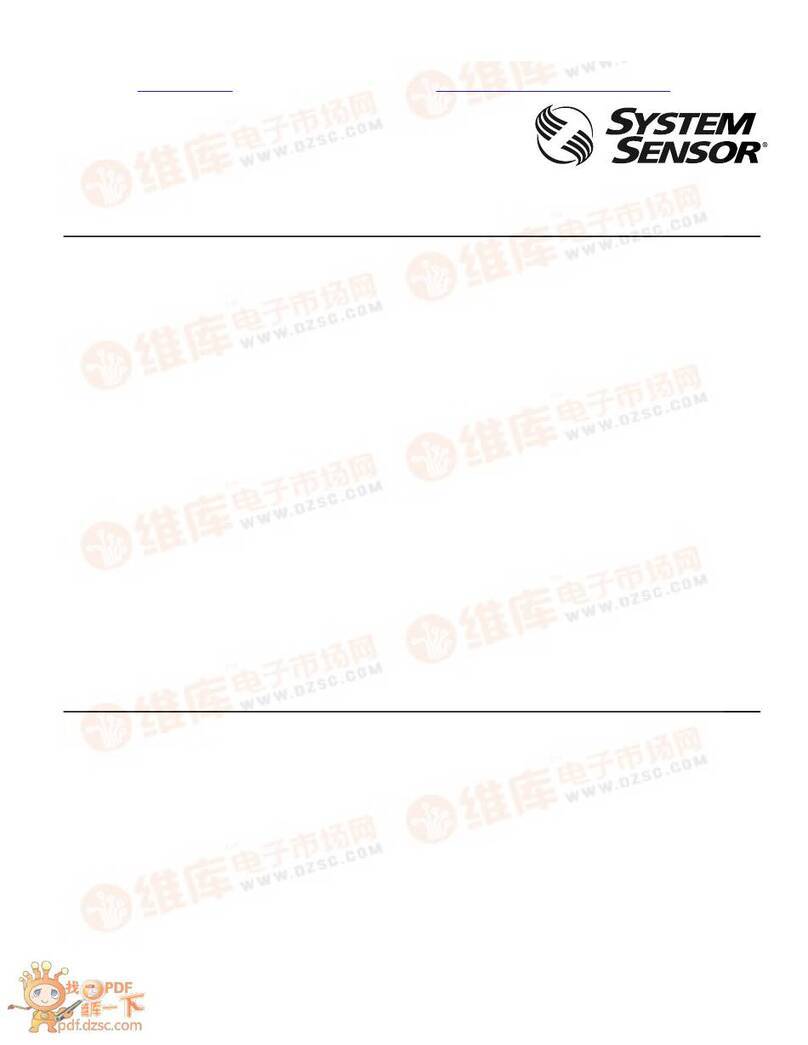
System Sensor
System Sensor B112LP Installation and maintenance instructions
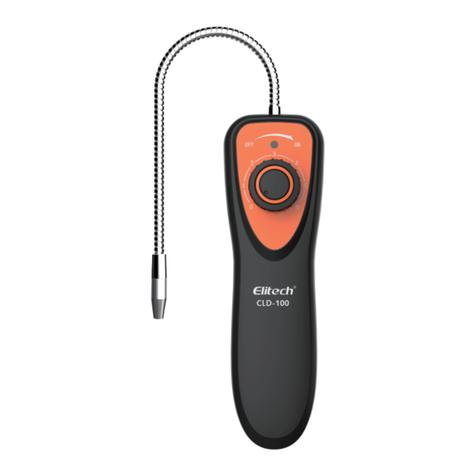
Elitech
Elitech CLD-100 instruction manual
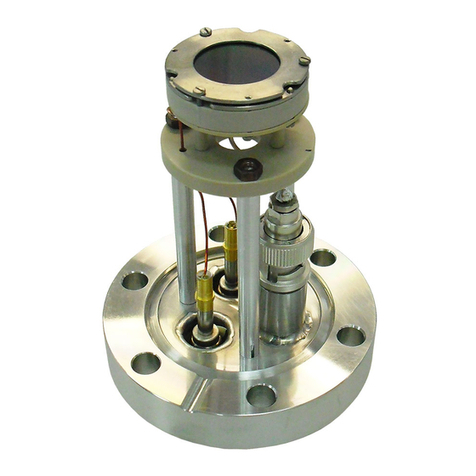
Surface Concept
Surface Concept MCPD18 manual
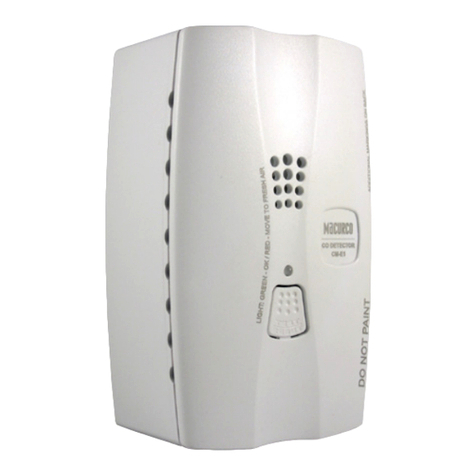
3M
3M Macurco CM-E1 User instructions
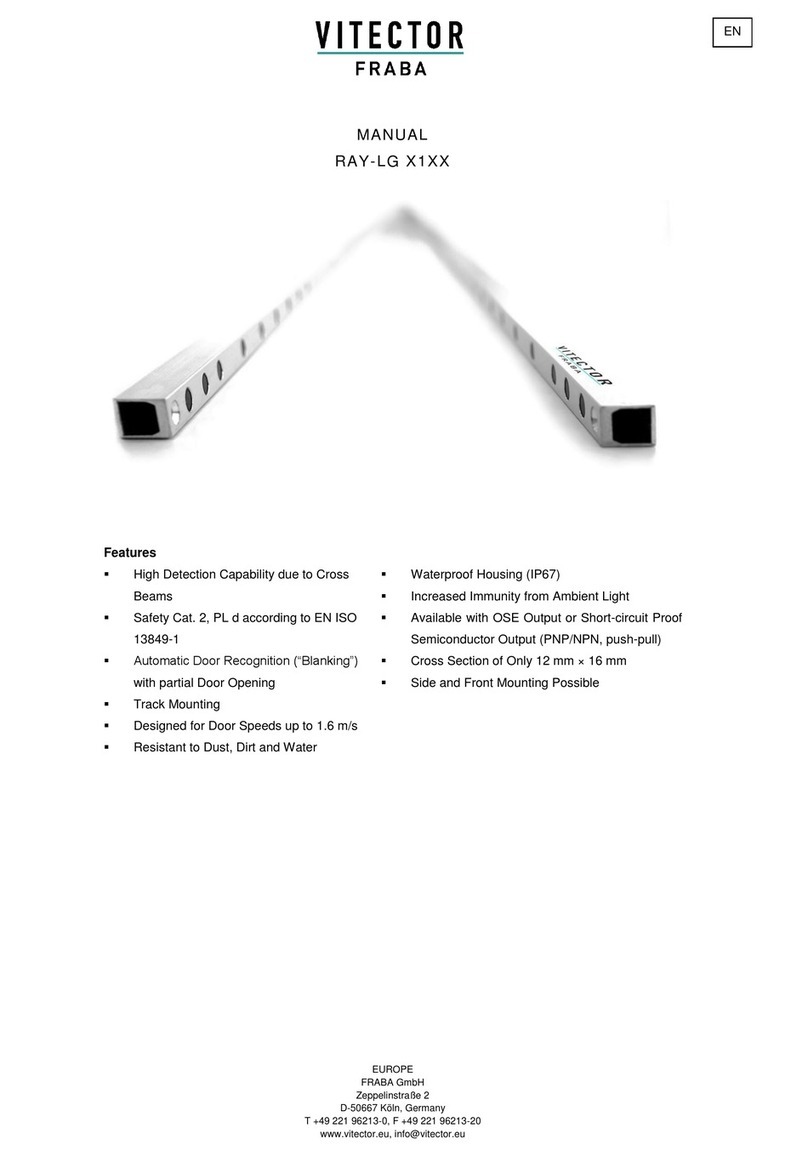
Fraba
Fraba Vitector RAY-LG Series manual
